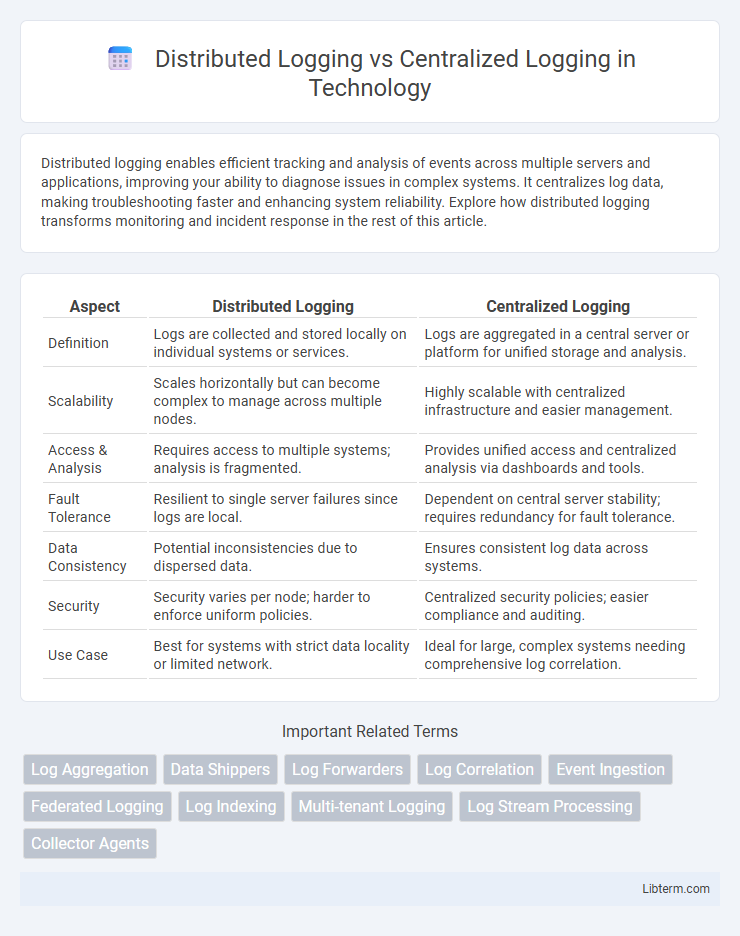Distributed logging enables efficient tracking and analysis of events across multiple servers and applications, improving your ability to diagnose issues in complex systems. It centralizes log data, making troubleshooting faster and enhancing system reliability. Explore how distributed logging transforms monitoring and incident response in the rest of this article.
Table of Comparison
| Aspect | Distributed Logging | Centralized Logging |
|---|---|---|
| Definition | Logs are collected and stored locally on individual systems or services. | Logs are aggregated in a central server or platform for unified storage and analysis. |
| Scalability | Scales horizontally but can become complex to manage across multiple nodes. | Highly scalable with centralized infrastructure and easier management. |
| Access & Analysis | Requires access to multiple systems; analysis is fragmented. | Provides unified access and centralized analysis via dashboards and tools. |
| Fault Tolerance | Resilient to single server failures since logs are local. | Dependent on central server stability; requires redundancy for fault tolerance. |
| Data Consistency | Potential inconsistencies due to dispersed data. | Ensures consistent log data across systems. |
| Security | Security varies per node; harder to enforce uniform policies. | Centralized security policies; easier compliance and auditing. |
| Use Case | Best for systems with strict data locality or limited network. | Ideal for large, complex systems needing comprehensive log correlation. |
Introduction to Logging in Modern Systems
Distributed logging captures logs from multiple services or nodes in a microservices architecture, enabling granular visibility and correlation across components. Centralized logging consolidates these logs into a single platform, simplifying search, analysis, and alerting for system-wide monitoring. Both approaches address the challenges of tracking events in complex, scalable systems but differ in data aggregation and management strategies.
Understanding Distributed Logging
Distributed logging captures log data from multiple sources within a distributed system, allowing for granular tracking of events across microservices, containers, and servers. This approach enhances fault diagnosis by correlating logs with specific services and timestamps, enabling efficient root cause analysis in complex architectures. Compared to centralized logging, distributed logging requires sophisticated tools to aggregate and analyze logs but offers higher resolution insights into system behavior and performance.
What Is Centralized Logging?
Centralized logging consolidates log data from multiple distributed systems into a single, unified platform for easier monitoring, analysis, and troubleshooting. It enhances efficiency by providing real-time visibility, reducing the complexities of managing logs spread across diverse sources such as servers, applications, and network devices. Tools like Elasticsearch, Logstash, and Kibana (ELK stack) are commonly used to implement centralized logging solutions that support scalable data aggregation and powerful search capabilities.
Key Differences: Distributed vs Centralized Logging
Distributed logging collects log data locally at individual nodes or services, enabling granular, context-specific insights but requiring complex aggregation for full system visibility. Centralized logging consolidates logs from multiple sources into a single repository, simplifying monitoring and analysis while potentially increasing latency and storage demands. The key difference lies in data accessibility and scalability: distributed logging excels in real-time fault isolation within microservices, whereas centralized logging streamlines cross-system correlation and compliance audits.
Advantages of Distributed Logging
Distributed logging enhances fault tolerance by enabling logs to be collected and processed locally across multiple nodes, reducing dependency on a single point of failure. It improves scalability and performance by distributing the logging load, minimizing latency and bottlenecks in high-traffic environments. Furthermore, distributed logging provides better context and granularity for troubleshooting complex, microservices-based architectures, facilitating faster root cause analysis.
Benefits of Centralized Logging
Centralized logging enhances system monitoring by aggregating logs from multiple sources into a single platform, improving real-time analysis and troubleshooting efficiency. It simplifies compliance and security auditing through consistent log storage and access control, reducing the risk of data loss. Centralized logging also supports advanced analytics and machine learning applications, enabling proactive identification of system anomalies and performance bottlenecks.
Challenges and Limitations of Distributed Logging
Distributed logging faces challenges such as inconsistent log formats, increased complexity in log aggregation, and difficulties in real-time correlation across multiple services or nodes. Scalability issues arise from the high volume of log data generated across distributed systems, leading to potential data loss or delays in log processing. Limited observability and fragmented insights hinder effective troubleshooting and make comprehensive analysis more time-consuming compared to centralized logging solutions.
Common Issues with Centralized Logging
Centralized logging often faces challenges such as single points of failure, which can result in data loss or downtime if the logging server goes offline. Scalability issues arise as the volume of logs grows, leading to performance bottlenecks in log ingestion and querying processes. Security concerns include the risk of unauthorized access to sensitive log data since all logs are aggregated in a single location, requiring robust access controls and encryption measures.
Choosing the Right Logging Approach for Your Infrastructure
Distributed logging captures logs at multiple points within a complex system, enabling granular monitoring and troubleshooting across microservices and distributed applications. Centralized logging aggregates data into a single platform, simplifying log analysis, storage, and alerting for infrastructure with fewer components or homogeneous environments. Selecting the right logging approach depends on factors like system complexity, scalability needs, latency tolerance, and the capacity for managing log volume and security.
Best Practices for Effective Logging Management
Effective logging management requires balancing the granularity of distributed logging, which captures detailed, service-level events, with the unified visibility of centralized logging, which aggregates logs from multiple sources into a single platform. Implement practice of consistent log formatting, use of structured logs (like JSON), and implementing log rotation and retention policies to optimize storage and retrieval. Deploy automated monitoring tools and alert systems on the centralized platform to quickly detect anomalies and ensure high system reliability.
Distributed Logging Infographic

 libterm.com
libterm.com